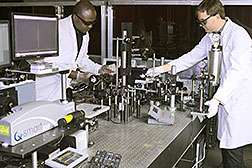Laser technology aids CO2 storage capabilities

DOE's National Energy Technology Laboratory is attracting private industry attention and winning innovation awards for harnessing the power of lasers to monitor the safe and permanent underground storage of CO2 resulting from fossil fuel combustion in power plants.
Carbon dioxide is a greenhouse gas and byproduct of burning coal, oil, and natural gas. There are increasing calls to isolate CO2 from the atmosphere to reduce its impact on global climate change. Once captured from a power plant, the CO2 can be piped into underground geologic formations for permanent storage. NETL experts are developing a technique, laser induced breakdown spectroscopy (LIBS), that can be used to validate that a storage site is not emitting CO2, or provide early detection of leaks when they do occur. Early leak detection will enable site operators to implement a faster mitigation response to stop the leak.
This innovative laser technology is ideal for this application because it can analyze solids, liquids, and gases quickly from a distance at little expense. Other lab-based monitoring techniques require samples to be brought in from the field, delaying analysis and exposing them to temperature and pressure conditions that could alter their chemistry.
The laser in this process emits pulses about five to 10 nanoseconds long. The laser pulses are focused onto a sample, creating a plasma of ions. Atoms in the plasma are excited and then relax, resulting in a spectral emission—a unique fingerprint of light. A fiber optic system delivers the spectral emission to an offsite spectrometer that is used to measure properties of the light and identify the materials it came from. As a result, LIBS can let researchers know within minutes if CO2 is leaking from a storage area by providing spectral data from the site for analysis.
The innovation has received the URS Pyramid Award and the 2013 Third Annual Energy and Innovation Conference Game Changer Award in recognition of its potential for CO2 monitoring. In addition, NETL recently received a patent for "downhole laser sensing technology" that can be used at well sites to detect significant changes in ion concentration in groundwater over the course of CO2 injection or other activities such as hydrofracturing. Dustin McIntyre, NETL researcher and developer of LIBS, said several outside organizations have contacted NETL regarding licensing the technology.
Provided by Oak Ridge National Laboratory




















